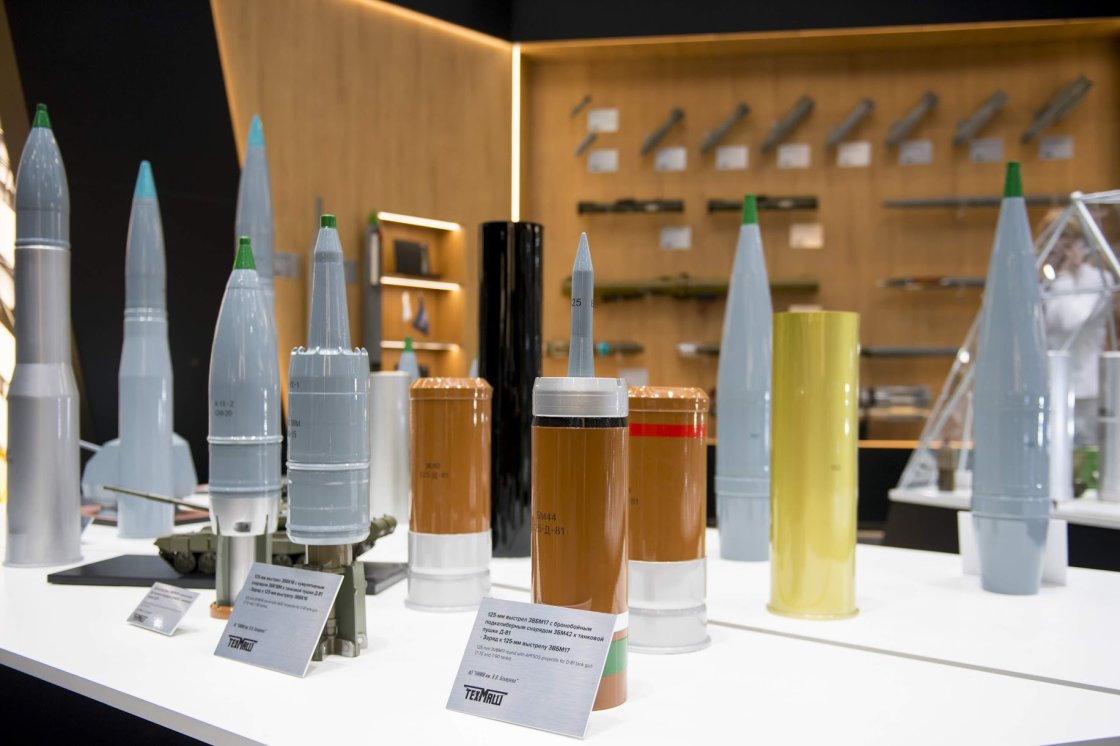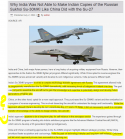You are using an out of date browser. It may not display this or other websites correctly.
You should upgrade or use an alternative browser.
You should upgrade or use an alternative browser.
Indian Military News, Reports, Data, etc.
- Thread starter bd popeye
- Start date
It's probably not worth discussing such copium, but surely the author realises that the Indian approach of "progressive domestic manufacturing" of the Su-30MKI, and nothing but the Su-30MKI, seems not to have achieved the stated goal to "gain the knowledge and expertise to potentially design and develop future generations of fighter jets."[China's reverse-engineering of Su-30MKK] did not necessarily result in a complete transfer of knowledge or the ability to design entirely new aircraft.
HAL Tejas isn't even a future generation of design, and still has not (to my knowledge) broken the three-digit airframe production number. On the other hand, China has definitely broken three-digit airframe production on J-10.
On the topic of future generations, J-20 has also broken three-digit airframe production number, and the HAL AMCA is still a pipedream (although it did receive some sort of funding approval recently).
4 July 2024

Rosoboronexport of the Rostec State Corporation organized the production of 3VBM17 “Mango” rounds with an armor-piercing sabot projectile in India. The ammunition is designed to destroy armored vehicles with combined protection. The project is being implemented under the Make In India program.
The 125 mm caliber "Mango" shot is designed for firing from the guns of T-72 and T-90 tanks. Various modifications of these combat vehicles are in service with the Indian Ground Forces.
“Rostec has significant experience in industrial partnerships with friendly countries. Many projects involve technology transfer and exchange of competencies. Such a partnership allows the importing country to develop its own production - this is Rostec’s competitive advantage as one of the leading suppliers of defense solutions. We have implemented several such projects in partnership with India. Among them is the licensed production of T-90 tanks, Mango shells with an armor-piercing sabot projectile and other weapon systems. To ensure the highest degree of localization of the production of Mango shells, in the future it is planned to launch the production of gunpowder in India,” said Sergei Chemezov, General Director of the Rostec State Corporation.
The Mango rounds include the 3BM42 finned armor-piercing sabot round. It allows you to hit modern tanks equipped with combined protection.
“The next important stage of Russian-Indian cooperation has been completed, meeting the requirements of the Make In India and Self-Reliant India programs. On the basis of the Indian defense holding, Rosoboronexport has prepared for launch key production facilities for the production of Mango tank rounds. This allows the Indian side to begin mastering the technology transferred to it and organize production,” said Alexander Mikheev, general director of the special exporting company. “Rosoboronexport’s work in India is a vivid example of a comprehensive industrial partnership, within the framework of which joint projects have been developed for all types of armed forces with a degree of cooperation between enterprises of the two countries that is unique for the world market.”
Rostec organized the production of Mango rounds in India

Rosoboronexport of the Rostec State Corporation organized the production of 3VBM17 “Mango” rounds with an armor-piercing sabot projectile in India. The ammunition is designed to destroy armored vehicles with combined protection. The project is being implemented under the Make In India program.
The 125 mm caliber "Mango" shot is designed for firing from the guns of T-72 and T-90 tanks. Various modifications of these combat vehicles are in service with the Indian Ground Forces.
“Rostec has significant experience in industrial partnerships with friendly countries. Many projects involve technology transfer and exchange of competencies. Such a partnership allows the importing country to develop its own production - this is Rostec’s competitive advantage as one of the leading suppliers of defense solutions. We have implemented several such projects in partnership with India. Among them is the licensed production of T-90 tanks, Mango shells with an armor-piercing sabot projectile and other weapon systems. To ensure the highest degree of localization of the production of Mango shells, in the future it is planned to launch the production of gunpowder in India,” said Sergei Chemezov, General Director of the Rostec State Corporation.
The Mango rounds include the 3BM42 finned armor-piercing sabot round. It allows you to hit modern tanks equipped with combined protection.
“The next important stage of Russian-Indian cooperation has been completed, meeting the requirements of the Make In India and Self-Reliant India programs. On the basis of the Indian defense holding, Rosoboronexport has prepared for launch key production facilities for the production of Mango tank rounds. This allows the Indian side to begin mastering the technology transferred to it and organize production,” said Alexander Mikheev, general director of the special exporting company. “Rosoboronexport’s work in India is a vivid example of a comprehensive industrial partnership, within the framework of which joint projects have been developed for all types of armed forces with a degree of cooperation between enterprises of the two countries that is unique for the world market.”
For all the Indian complaints on T-72/T-90 family... guess they're going to stay for a long time.
India bought Su30MKI as a whole package with technology transferred so they can be operated by a military that didn't have the technology level before.
Whereas China's access to the flanker airframe is an unrestricted license, which made sense for China to acquire because they're interested in using it as foundation for mass produced future projects.
Last edited:
July 5, 2024

The Russian-Indian joint venture Indo-Russian Rifles Private Limited, registered and located in India, produced and transferred 35 thousand Kalashnikov AK-203 assault rifles to the Indian Ministry of Defense. The founders of the enterprise on the Russian side are Rosoboronexport and the Kalashnikov concern of the Rostec State Corporation.
The Kalashnikov AK-203 assault rifle is a version of the AK-200 assault rifle chambered for the 7.62x39 mm cartridge used in the Indian Army. The weapon has the traditional advantages of Kalashnikov assault rifles: reliability and ease of maintenance.
“Rostec produces a wide range of weapons that have proven their effectiveness in real combat conditions, including the latest small arms. Today, India is the first foreign customer to begin producing the “200th” series of Kalashnikov assault rifles. Product production has been launched in India in full compliance with the Make In India and Self-Reliant India programs. The project includes technology transfer; its concept includes 100% localization of AK-203 production. Such programs are one of the trends in the modern arms market and Russia’s competitive advantage as a reliable supplier of the best defense solutions,” said Sergei Chemezov, Director General of the Rostec State Corporation.
AK-203 are manufactured in India using exclusive Russian technologies using certified equipment. This ensures high quality products and compliance with the declared characteristics.
“The joint venture Indo-Russian Rifles Private Limited, one of the founders of which on the Russian side is Rosoboronexport, has completed the first phase of the project for the production of Kalashnikov AK-203 assault rifles in India. To increase the degree of localization, all necessary equipment has been shipped to the Korwa Ordnance Factory in Amethi, Uttar Pradesh, and production facilities have been fully equipped. This made it possible to produce and supply the Indian army with a batch of 35 thousand Kalashnikov assault rifles within the timeframe agreed upon with the Indian Ministry of Defense,” said Rosoboronexport General Director Alexander Mikheev. “The Russian-Indian joint venture is a vivid example of fruitful cooperation between our countries in the defense sector.”
Today, Russia and India continue to implement projects in the area of military-technical cooperation. Current and future programs are based on the maximum focus of the parties on technological interaction.
Rostec: a Russian-Indian joint venture supplied 35 thousand AK-203 to the Indian Army

The Russian-Indian joint venture Indo-Russian Rifles Private Limited, registered and located in India, produced and transferred 35 thousand Kalashnikov AK-203 assault rifles to the Indian Ministry of Defense. The founders of the enterprise on the Russian side are Rosoboronexport and the Kalashnikov concern of the Rostec State Corporation.
The Kalashnikov AK-203 assault rifle is a version of the AK-200 assault rifle chambered for the 7.62x39 mm cartridge used in the Indian Army. The weapon has the traditional advantages of Kalashnikov assault rifles: reliability and ease of maintenance.
“Rostec produces a wide range of weapons that have proven their effectiveness in real combat conditions, including the latest small arms. Today, India is the first foreign customer to begin producing the “200th” series of Kalashnikov assault rifles. Product production has been launched in India in full compliance with the Make In India and Self-Reliant India programs. The project includes technology transfer; its concept includes 100% localization of AK-203 production. Such programs are one of the trends in the modern arms market and Russia’s competitive advantage as a reliable supplier of the best defense solutions,” said Sergei Chemezov, Director General of the Rostec State Corporation.
AK-203 are manufactured in India using exclusive Russian technologies using certified equipment. This ensures high quality products and compliance with the declared characteristics.
“The joint venture Indo-Russian Rifles Private Limited, one of the founders of which on the Russian side is Rosoboronexport, has completed the first phase of the project for the production of Kalashnikov AK-203 assault rifles in India. To increase the degree of localization, all necessary equipment has been shipped to the Korwa Ordnance Factory in Amethi, Uttar Pradesh, and production facilities have been fully equipped. This made it possible to produce and supply the Indian army with a batch of 35 thousand Kalashnikov assault rifles within the timeframe agreed upon with the Indian Ministry of Defense,” said Rosoboronexport General Director Alexander Mikheev. “The Russian-Indian joint venture is a vivid example of fruitful cooperation between our countries in the defense sector.”
Today, Russia and India continue to implement projects in the area of military-technical cooperation. Current and future programs are based on the maximum focus of the parties on technological interaction.
A couple of videos with some updates.
LEX-03 landing from a carrier aircraft. No immediate use cases, but helps to build up expertise.
India apparently approved the use of some new energetic materials. Including SEBEX-2, SIMEX 4 and SITBEX-1. Not certain the production capacity/TRL level is though. But pretty big news.
LEX-03 landing from a carrier aircraft. No immediate use cases, but helps to build up expertise.
India apparently approved the use of some new energetic materials. Including SEBEX-2, SIMEX 4 and SITBEX-1. Not certain the production capacity/TRL level is though. But pretty big news.
I remember indians downplaying ZTQ-15s in Ladakh because their T72s can supposedly go there with ease. Now nearly a decade later, they want to replicate China lol
Also a lot of this tank is not indigenous like the engine and whole turret. The hull looks similar to the ZTQ-15 too.

